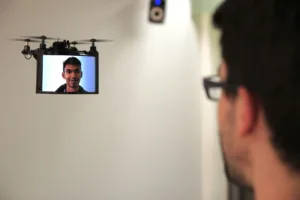Multiple methods are being developed to work with virtual reality, most involving an additional wearable, or some form of external camera. But what if the interaction became physical?
![]() The Human Media Lab of Queen’s University in Canada (and Belfast) has developed self-levitating 3D ‘pixels’ (voxels), using tiny drones. The system is known as BitDrones, and can be used to explore virtual information by using the drones as interaction points. They are being described as ‘the first step towards creating interactive self-levitating programmable matter – materials capable of changing their 3D shape in a programmable fashion’.
The Human Media Lab of Queen’s University in Canada (and Belfast) has developed self-levitating 3D ‘pixels’ (voxels), using tiny drones. The system is known as BitDrones, and can be used to explore virtual information by using the drones as interaction points. They are being described as ‘the first step towards creating interactive self-levitating programmable matter – materials capable of changing their 3D shape in a programmable fashion’.
Three types of drone have been created: ‘PixelDrones’ feature a single LED and a small dot matrix display. ‘ShapeDrones’ are housed in a lightweight mesh and 3D-printed geometric frame, for use as building blocks in 3D models. ‘DisplayDrones’ carry a curved, flexible touchscreen, forward-facing video camera and Android smartphone SoC.
All three types feature reflective markers; this enables them to be individually tracked and positioned in real-time through motion capture technology, using wall-mounted cameras. These also track users’ hand movements and touch to manipulate the voxels.
A number of scenarios have been described – and some are shown in a video (http://tinyurl.com/pp8xjrt and embedded below). For example, physically exploring a file folder, using drones as menu items (one drone acts as the ‘folder’, and the others fly in a horizontal wheel nearby to act as ‘files’). They could also be used to create a 3D model while simultaneously performing a video call on Skype.
The system currently supports about a dozen 2.5″ – 5″ drones. In the future, the team intends to support ‘thousands’ of drones measuring no more than 0.5″.

